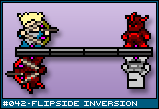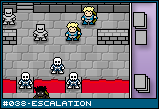| Three Hundred |
| - Index Page |
| - About... |
| - By Year |
| Collections |
| - Comp-Grid |
| - Procedural |
| - Tactics |
| - Tiny Crawl |
| - Misc |
| Previous | Mechanic #042 | Next |
|
![[invert1.png]](set03/img/entry042-invert1.png)
This is actually a different idea than [#041 - Flipside], but it shares the same core concept of playing on two sides of a single board. As before, these two images represent the two sides of a single plane - the light side and the dark side. The dark side is flipped, which is most obvious with the little arrows and their destination squares. As you can see, there are light and dark units on both sides. If you are really perceptive, you may notice that there is a one to one correspondance. That is, where there is a light archer on one side, there is a dark archer on the other side at exactly the same place. To better illustrate the point: ![[invert2.png]](set03/img/entry042-invert2.png) This is your unit. You share units with your opponent. You may only move the unit from your own side (why will become apparent in a moment), but doing so makes the other unit move as well. You cannot move anywhere that both units cannot move. They are locked together for all intents and purposes. If one of the members dies, then the remaining half of the unit is free to do as he wishes without a shadow holding him back. When your unit attacks, the shadow unit attacks equally. That means that if you attack three spaces in front of you, so will your shadow. The difference being that moving and attacking with a unit doesn't change the facing of the shadow unit. Since I don't have facing in the first example (mainly because I haven't drawn all those new units from the back yet), here's an example: ![[invert3.png]](set03/img/entry042-invert3.png) Here, the light archer will attack three spaces away to hit one of the demon warriors. Unfortunately (or fortunately, as the case may be), his shadow unit is facing a different direction because of an attack in a previous turn. The shadow archer will fire three spaces away in the direction he is facing too, hitting whatever may be there, if anything. So, you've got to keep track of what your shadow is about to do and plan accordingly. |
![[invert4.png]](set03/img/entry042-invert4.png)



